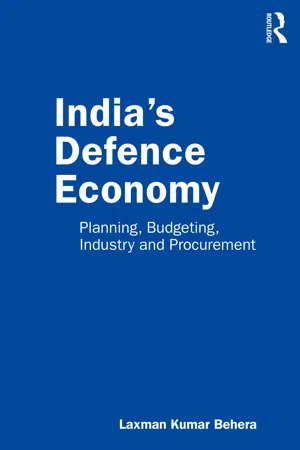
India's Defence Economy
Planning, Budgeting, Industry and Procurement
- 198 pages
- English
- ePUB (mobile friendly)
- Available on iOS & Android
About this book
As the fourth largest military spender in the world, India has a huge defence economy supported by a budget amounting to nearly $67 billion in 2020–21. This book examines how well India's defence economy is managed, through a detailed statistical exposition of five key themes – defence planning, expenditure, arms production, procurement and offsets.
This book is based on hard-core evidence collected from multiple government and other credible sources including the ministries of Defence, Finance, and Commerce and Industry, Comptroller and Auditor General of India and the Reserve Bank of India. It discusses key issues such as the evolution of India's defence plan; the feasibility of increasing defence spending; India's defence acquisition system; and the recent reform measures taken under the rubric of the 'Make in India' initiative.
Well supplemented with original tables and figures, India's Defence Economy will be indispensable to students and researchers of defence and security studies, politics and international relations, finance, development studies, economics, strategic studies, South Asian politics, foreign policy and peace studies. It will also be of interest to defence ministry officials, senior armed forces personnel, military attachés, defence training institutes and strategic think tanks.
Frequently asked questions
- Essential is ideal for learners and professionals who enjoy exploring a wide range of subjects. Access the Essential Library with 800,000+ trusted titles and best-sellers across business, personal growth, and the humanities. Includes unlimited reading time and Standard Read Aloud voice.
- Complete: Perfect for advanced learners and researchers needing full, unrestricted access. Unlock 1.4M+ books across hundreds of subjects, including academic and specialized titles. The Complete Plan also includes advanced features like Premium Read Aloud and Research Assistant.
Please note we cannot support devices running on iOS 13 and Android 7 or earlier. Learn more about using the app.
Information
1
Planning for India’s defence
Introduction
Why planning in defence?
Evolution of India’s defence five-year plan and associated structures
Plan | Plan Projection (INR in Billion) | Budget Allocation (INR in Billion) | Actual Expenditure (INR in Billion) | Status |
|---|---|---|---|---|
1st Plan (1964–1969) | 50 | 46.36 | 46.01 | The plan, prepared in the aftermath of Chinese aggression in 1962, was prepared under the aegis of Planning Committee set up in the MoD. The plan was ambitious and didn’t have assurance of resources to support it. It was also not based on long-term requirements. |
2nd Plan (1969–1974) | NA | 65.12 | 71.59 | The plan didn’t run its full course as a new roll-on plan was introduced just one year into the plan period. |
3rd Plan (1970–1975) | NA | 73.17 | 81.70 | The plan, based on roll-on concept, was abandoned in the wake of 1971 war and the financial constraints of early 1970s. |
4th Plan (1974–1979) | NA | 124.30 | 126.48 | Plan was prepared under the aegis of the Planning Group set up under the chairmanship of the Planning Minister. Soon after the plan was launched, it was subjected to major modifications in view of large-scale arms acquisitions by Pakistan, West Asia War of October 1973 and major hike in international crude oil prices. The MoD briefly thought of replacing the plan with a roll-on plan 1976–1981. |
5th Plan (1979–1984) | NA | 219.21 | 235.92 | Plan was prepared under the aegis of Committee on Defence Planning (CDP), which was headed by the Cabinet Secretary and included as members the Principal Secretary to the Prime Minister (PM), Defence Secretary and Finance Secretary, among others. To support the CDP, an in-house Defence Plan Coordination and Implementation Committee (DPC&IC) was created in the MoD under the chairmanship of the Defence Secretary. The plan was abandoned one year after it was announced due to the change in security environment, acquisition of modern weapons by India’s neighbours and in view of making defence plan co-terminus with the national plan. |
6th Plan (1980–1985) | NA | 256.71 | 268.97 | It is the first plan to have received the approval of the Cabinet Committee on Political Affairs (CCPA), though the approval came nearly two years after the commencement of the Plan. |
7th Plan (1985–1990) | 719.38 | 549.26 | 581.90 | During the Plan, the Directorate General of Defence Planning Staff (DPS) was set up to assist the Chiefs of Staff Committee (CoSC). The DPS didn’t make much headway. At one point of time, six DG were replaced in a matter of six years. Though the Plan received CCPA approval, it came in the fourth year of the plan. The MoF approval came in the last year of the plan. |
8th Plan (1992–1997) | ~1,400 | 1,129.78 | 1,190.33 | Initially planned for 1990–1992, it wa... |
Table of contents
- Cover
- Half Title
- Title Page
- Copyright Page
- Table of Contents
- List of figures
- List of tables
- Preface
- Acknowledgements
- 1 Planning for India’s defence
- 2 Bang for the buck: India’s defence expenditure since independence
- 3 The defence – GDP debate
- 4 Towards a vibrant defence industrial base
- 5 Reforming India’s defence procurement
- 6 Offsetting India’s arms import
- 7 Conclusion: Managing India’s defence economy
- Annexure I
- Annexure II
- Annexure III
- References
- Index